Picking between longbows and recurves might be challenging for beginners getting into traditional archery or hunting.
In this article, we'll comprehensively compare longbow vs. recurve.
We'll look at:
- Differences between the long bow and recurves
- What are their pros and cons?
- Which one is for beginners and hunters
Let's dive in:
What is a Longbow?
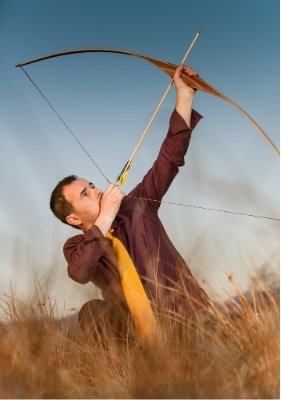
A longbow is a type of bow that's longer than regular bows. Its length is about 1.8 meters, and widely used for hunting and warfare purposes.
English longbow has a high draw weight ranging from 60 to 180 pounds (270 to 810 Newton) and requiring great strength and skill to handle effectively.
What does it mean?
It means that you’ll need a lot of force to pull back the bowstring to its full draw position.
The bow's length provides a greater distance compared to other bows.
Modern longbow is practiced in various archery disciplines and hunting.
What is Recurve Bow?
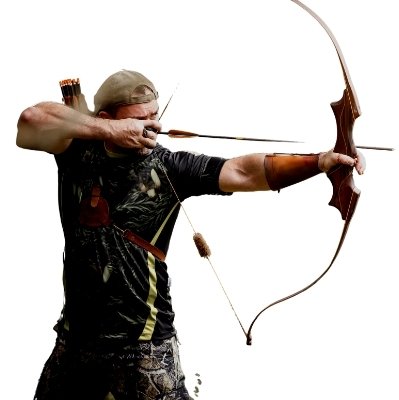
A recurve bow is a type of bow that has limbs that curve away from the archer when unstrung.
This design allows the bow to store more energy and deliver more power to the arrow than a traditional longbow.
Recurve bows are commonly used in archery and are often made from a combination of wood, fiberglass, and carbon fiber materials to achieve the desired balance of strength and flexibility.
Longbow Vs Recurve (Deep Comparison):
1. Basic Design:
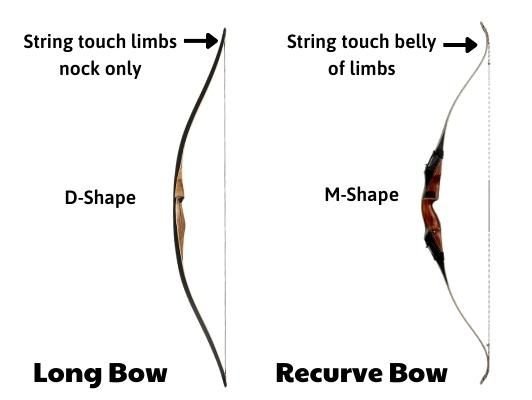
Shape
Generally, a long bow is straight when not strung and curved (D-shaped) when strung.
Recurve has a more wavy form that resembles an "M."
But be aware that there might be overlap because of modern hybrid designs.
Material
The one-piece long bow is usually made of a single piece of wood carved to the desired shape.
Recurve bows are made of several layers of laminated wood or composite materials such as fiberglass and graphite.
String
When strung, the string on the long bow does not touch the belly but one point at the string nock (end of the limbs).
On the other hand, recurve bow has the string sit against the belly of the limb.
2. Anatomy:
Recurve bow parts:
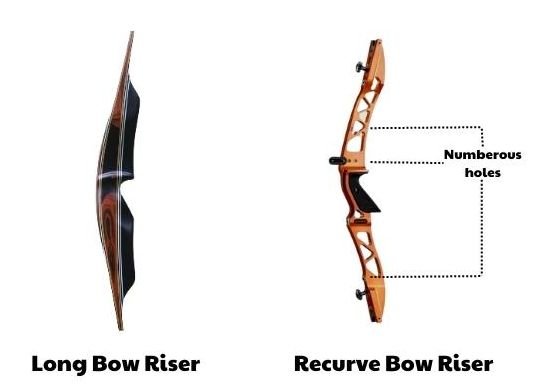
Risers on recurve bows are made of different materials, such as aluminum, carbon fiber, or wood.
Besides that, there are numerous holes on the risers for mounting extra gear, such as sights, stabilizers, and arrow rests…
The bow can be cut past the center.
The grip has more “meat” and several styles that the longbow doesn’t have, such as:
- High wrist
- Standard straight wrist
- Low wrist
The limbs on recurves are thinner and wider than the long bow, but they store more energy.
Besides that, there are various lengths from 48” to +70” that can fit your needs and desires.
Longbow parts:
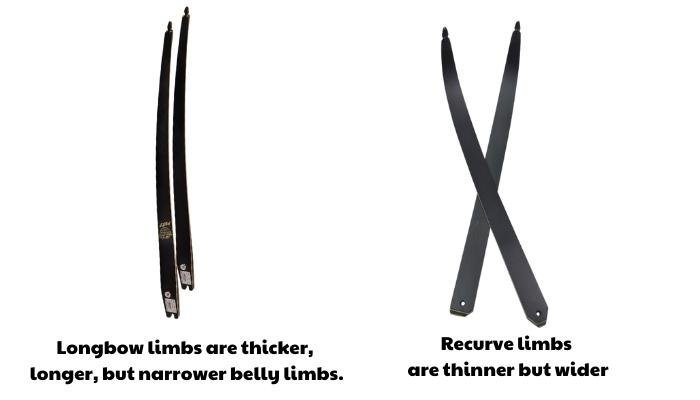
The long bow has thicker, longer, but narrower belly limbs.
The riser is also smaller, making them smoother to shoot due to its limited range of motion.
Modern longbows come in a wide range of styles and materials.
3. String “pinch”:
Recurve bows produce more "pinch" (injury to your fingers) on the string, which results in a less smooth release and impact on your accuracy.
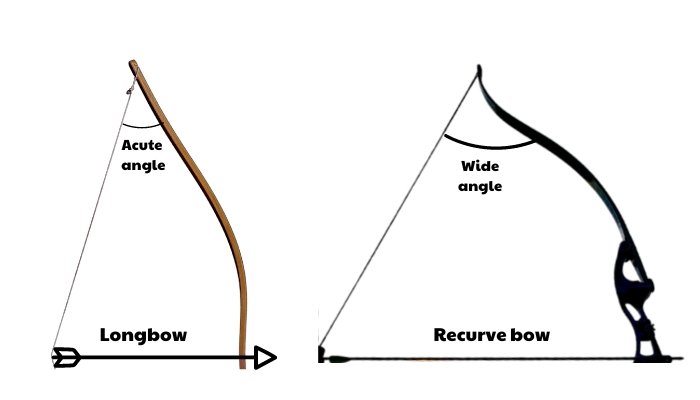
Longbows have far more gentle and acute string angles because the limb tips flex less, making them more stable and smoother to shoot. You’ll have less string pinch or finger injury.
The secret behind it:
The longer the limbs, the less likely the string moves out of the center, and the more stable it is because the limbs don't have to move so far.
Sounds cool, right?
4. Drawing Experience:

In general, a long bow is better for instinctive shooting (a kind of traditional shooting with no sight) thanks to its lighter draw and slower speed.
You’ll feel light draw at the beginning but firmer at anchor.
On the contrary, a recurve is better for aiming because it has a faster speed and heavier draw.
You’ll feel firmer at the beginning, but the light at the anchor, which is comfortable to hold the anchor for a longer time.
This is crazy:
When the string lifts from the return curve, recurves also have a slight let-off effect that makes you feel easier to draw, but after that, the power is added pretty quickly.
That’s why you have the feeling of firm first and light later above.
5. Forgiveness:

Longbows are more forgiving and easier to shoot than recurves since you don’t need to discipline drawing techniques strictly.
Although you’ll still need the correct archery technique, a minor error won’t affect your accuracy.
Besides that, you can't twist the limb tips from side to side.
Want to know why?
This is because long bows limbs are heavier and more difficult to twist than a recurve.
It means you’ll have a more steady shot due to the limbs' forward motion upon release.
But after release, you’ll have more string slaps and hand shock than recurve bow.
Recurve is less forgiving
If you don't have proper form, the limbs will often torque when you release them.
A minor change in form, bow materials, and tunning might significantly impact the accuracy.
6. Accuracy:
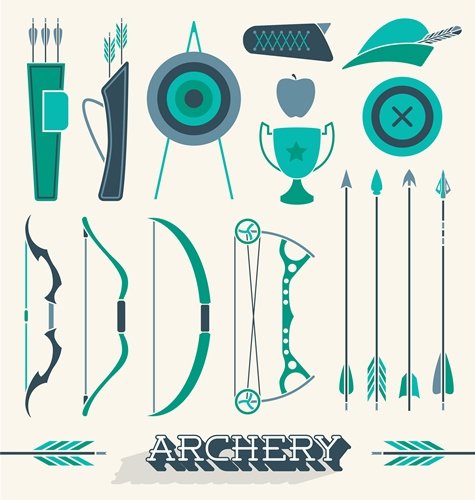
The accuracy of a recurve bow ranges from 40 to 400 yards, while that of a longbow is from 30 to 100 yards.
Recurve bows are more accurate than longbows due to their shorter length and more complex design with additional gears.
What does this mean?
You can shoot arrows more accurately with tons of gear, making them ideal for target shooting and competitions.
7. Draw Weight:
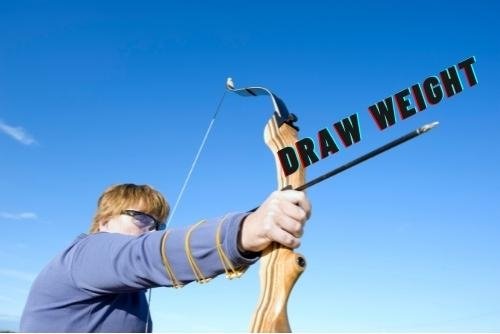
What is draw weight?
A bow's draw weight is the force required to pull the bowstring back to a fixed position.
The draw weight of a longbow is from 60 to 180 pounds, while that of a recurve bow is between 50 to 70 pounds.
Longbows usually have higher draw weights than recurve bows.
Why is it important?
Higher draw weight means:
- Recurve bow is easier to pull than a longbow
- You have to prepare strong muscles to draw a long bow
- More power equals a faster arrow speed (more on that below).
8. Power and Speed:
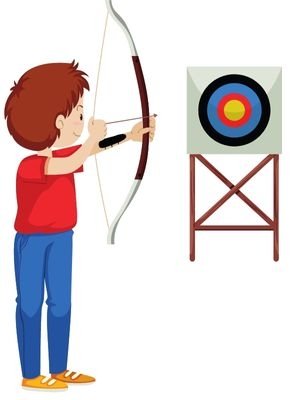
Recurves are more powerful and faster than longbows, which I find to be much more satisfying.
They also provide nicer tactile feedback and push straighter arrow trajectories, making them slightly more accurate overall.
Let me tell you:
A recurve's design allows for greater energy storage and release, resulting in faster arrow speeds.
How much faster?
Recurves travel 10–20 feet per second faster than longbows of the same draw weight and length.
9. Noise and Vibration:
Longbows are quieter and produce less vibration than recurve bows due to their simpler design and "no string slap."
Recurve bows, on the other hand, produce more noise and vibration due to more powerful limbs.
10. Draw Length:
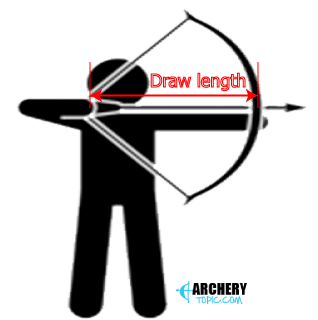
When you stretch your bowstring, the distance between the stretched string and your grip on the bow is called "draw length."
The draw length of a longbow is between 28 inches (71.12 cm) and 45 inches (114.3 cm), while a recurve bow is between 17 to 30 inches.
Longbows have a longer draw length than recurve bows, so you can shoot arrows to a longer distance than recurve bows.
11. Maneuverability:
Longbows have a length of 1.8 meters and a weight of 60 to 180 pounds, while recurve bows have a size of 1.4 meters and a weight of 50 to 70 pounds.
This shows that longbows are longer size and bulkier than recurve bows.
What does it mean?
It means they are less maneuverable in tight spaces.
12. Maintenance:

Via lancasterarchery.com
Both longbow and recurves are easy to maintain no matter what they’re made of, including:
- Stringing
- Unstring when not used
- Waxing and drying to avoid moisture and lengthen the bow life.
13. Versatility:
Recurve bows are often more versatile than longbows.
This is because you can easily modify them with accessories like stabilizers, sights, and quivers to suit different shooting styles.
14. Stealth:

Via The Huntin Grounds
Longbows don't have string contact with the bow's limbs when the arrow is released. They are quieter and get an advantage for hunting.
It makes the hunting process more stealthy and silent, preventing sensitive animals from noticing your arrow's release and jump string easily.
15. Transport:
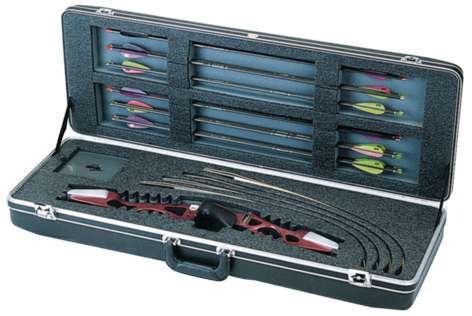
A recurve bow is generally more portable than a one-piece longbow due to its compact design.
Recurve bow limbs may be disassembled into 3 pieces and stored in a compact bow case, making them incredibly portable.
But note that modern taken-down longbows (2 pieces) also have the same mobility function.
So take a 2 pieced longbow if you want mobility.
Pros and Cons:
Here is the recap of pros and cons:
Features | Long Bow | Recurve Bow |
|---|---|---|
Shape | D-shape | M-shape |
Material | Wood | Wood, fiberglass or graphite |
String | Touch at the limb nock | Touch at limb belly |
String “pinch” | Less | More |
Drawing experience |
Lighter draw at the beginning but firmer at anchor. |
Firmer at the beginning but the light at anchor. |
Forgiveness |
More forgive |
Less forgive |
Accuracy |
More |
Less |
Draw weight |
More |
Less |
Power and speed |
Weaker and slower |
More powerful and faster
|
Noise and vibration |
Less noise and vibration |
More noise and vibration |
Draw length |
Longer |
Shorter |
Maneuverability |
Longer and bulkier |
More compact |
Maintenance | Easy | Easy |
Versatility |
Less versatile |
More versatile |
Stealth |
More |
Less |
Transport |
Easy |
Easy |
So Which one is Better for Hunting?

The recurve bow is better and more practical for hunting than the longbow.
This is because the recurve bow has a more compact and efficient design that is faster speed and more accurate.
Its shorter length and curved limbs also make it easier to maneuver in tight spaces such as a tree stand or brush.
Additionally, you can easily disassemble them for easy transport and storage.
Which one is Better for Beginners?
Well, both recurve bow and a longbow is good for beginners who get into the fundamental of archery.
You should go to the local archery shop and try both and start light. Go with whatever you love.
Bottom Line:
At this point, I believe you should know the differences between longbow vs recurve.
Here’s my conclusion:
- Longbows tend to be the connoisseur’s choice.
- Recurves tend to be for people who want performance.
So which one do you prefer? Feel free to leave a comment below.
